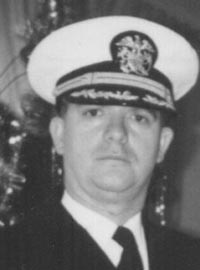In Memoriam: Michael S. Terpilak, CHP
1928-2007
by Edward A. Tupin, CHP

Michael S. Terpilak, a retired commissioned officer in the United States Public Health Service (PHS), died 11 April 2007 in Silver Spring, Maryland, due to complications of a stroke. Mike was a practical field health physicist who was always willing to accept new challenges and help others become better at what they did. Mike was born on the lower east side of Manhattan and lived there until his late 20s. In his youth, he attended Polish Catholic Parochial School and was an altar boy. He later attended Cardinal Hayes High School in the Bronx. After graduating from New York University, he served in the Army during the Korean War.
After that, he returned to New York City to work for the Department of Health for the city of New York. That job piqued his interest in health-related occupations, which led him to become a public health sanitarian and a certified health physicist.
He worked as a health physicist at the Ginna Nuclear Power Plant in Rochester, New York, during the early days of that plant. Subsequently, he joined the Commissioned Corps of the PHS as a sanitarian. Mike was assigned to the PHS's Bureau of Radiological Health (BRH) in the radioactive material program, where he did investigations on radon daughters found in jewelry made from spent radon seed used in cancer therapy in the 1920s and 1930s.
Because of his interest in jewelry, he worked with the gold industry to try to devise guidelines for preventing radioactively contaminated gold from entering the industrial and jewelry market. He also brought attention to the importation of gem stones from South America that had been exposed to neutron radiation to enhance their color. He was secretary/treasurer of Bethesda Jewelers, a full-service jewelry store in downtown Bethesda, operated by his wife and son.
He was the health physicist for the refueling and decommissioning of the nuclear power cargo ship NS Savannah. He also wrote health physics procedures for the Army Package Power nuclear reactor and subsequently went to Antarctica to support the reactor's installation at McMurdo Sound.
Mike played key roles in the BRH response to the accident at Three Mile Island, both in determining the actual status of the reactor and in briefing senior staff in the Department of Health, Education, and Welfare.
Whenever radiation was found in miscellaneous applications, Mike was involved with the state radiation agencies and the BRH to get information disseminated to minimize the use of such sources. He had a strong interest in training health physicists through most of the time he was in the PHS. He retired from the PHS as sanitarian director in 1982.
Mike was very active in the Baltimore-Washington Chapter of the Health Physics Society (BWCHPS), serving as president in 1971. He started the first American Board of Health Physics (ABHP) certification course in the chapter in 1966-1967. In 1968 he received one of the first two BWCHPS Distinguished Service Plaques for the effort. He was also very active in the ABHP, serving as a member of the Comprehensive Examination Panel from 1969 to 1975 and as chair from 1974 to 1975. Mike and Anthony Greenhouse authored the brochure "Certified Health Physicist" in 1974. In 1975, when the National Registry of Radiation Protection Technologists (NRRPT) formally organized, Mike was one of two ABHP members selected to serve on the initial NRRPT Board of Directors. He also served as a member of the ABHP from 1976 to 1980, serving as secretary-treasurer from 1977 to 1978 and chairman from 1979 to 1980. After leaving the board, he was hired as the first (part-time) executive secretary for the ABHP, a role which he fulfilled until 1983.
After his retirement from the PHS, he was cofounder of Nucleon Lectern Associates, a health physics consulting and education company that published the first commercial version of the The Health Physics and Radiological Health Handbook, which was used by health physicists around the country. He continued to serve the health physics community working for, and as a consultant to, many federal agencies, including the Smithsonian Institution, the U.S. Food and Drug Administration, the Federal Bureau of Investigation, the U.S. Nuclear Regulatory Commission, the Secret Service, and many private companies.
He also was active in the local chapter of the American Association of Radon Scientists and Technologists. Just prior to his death he was a part-time radiological consultant with Bishop & Associates in Baltimore.
He is survived by his wife Katherine, 1916 Grayslake Dr., Silver Spring, MD 20906; his son Thomas and daughter-in-law Sue of Clarksburg, Maryland; and his son Jeffrey of Silver Spring, Maryland.
Thanks to John Villforth and Syd Porter for their contributions to this article.




